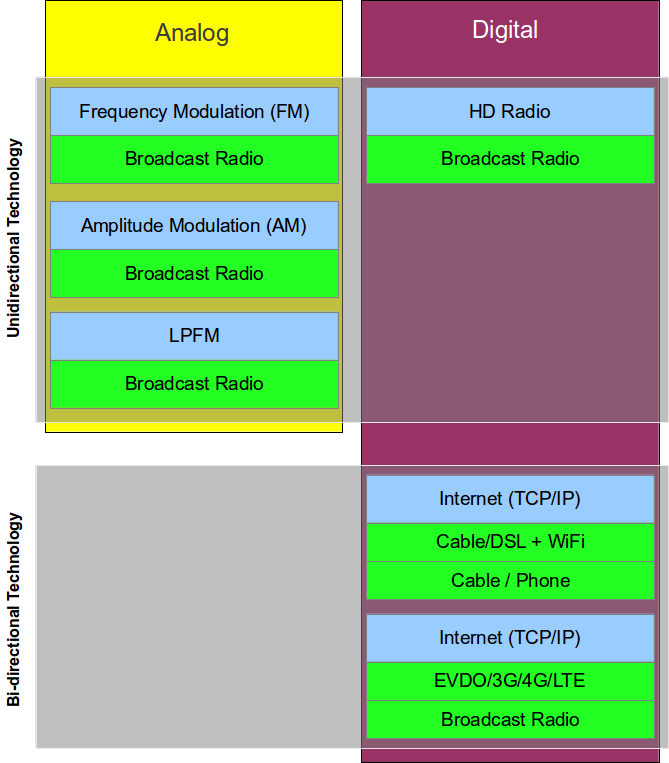Digital vs. Analog Radio Broadcasting: A Slightly Apocryphal Explanation
08 Mar 2013 Charles Choi
Whenever the topic of radio and online comes up, I generally find myself in a place where not everybody is on the same page when it comes to talking about the actual technology of radio. Understanding the basic structure of radio technology can't be understated enough because it sets a ground floor on the discussion of two things:
- People who care about radio and how the Internet affects it.
- Public policy on FCC broadcast spectrum allocation.
In what follows I aim to present a technically imprecise, yet directionally correct description of radio technology to hopefully clarify the discussion on this topic.
First off is presenting a conceptual model of a network which consists of two layers:
-
A physical layer which is the medium through which information is communicated. This medium can for example be a copper wire or a radio wave.
-
A logical layer which defines how the information transmitted over the physical layer is to be organized.
These layers can be sub-divided into more layers but that's outside our discussion here. The core thing to get is that with a network there is a logical and a physical notion of communication working together in concert here.
The following figure below shows the stack configuration of this network, where the logical layer builds upon and abstracts actions that happen in the physical layer.

Now let's apply this network model to describing radio:

Analog Unidirectional Broadcast
Amplitude Modulation (AM), Frequency Modulation (FM), and Low Power FM (LPFM) are analog unidirectional radio technology. They are unidirectional meaning that there is a single point of broadcast and the devices that listen to them can not directly communicate back (duh). All are dependent on using broadcast radio as the physical layer, which is dependent on the frequency spectrum that is typically allocated by the governing state. In the United States, the authority responsible for allocating this frequency spectrum is the FCC. AM, FM, and LPFM can be thought of as the logical layer by using different modulation techniques at different levels of broadcast power. All these approaches are analog-based in that the original source signal is transmitted in a way that attempts to maintain its shape from source to receiver.
Digital Unidirectional Broadcast
HD Radio is a unidirectional radio technology which uses digital technology for its logical layer. The original source signal is converted to bits which are then transmitted from the broadcast source to the receiver. The receiver then reconstructs the bits into the source signal with a varying degree of fidelity.
Bi-directional Digital Broadcast
With "Internet Radio" (streaming or download), the logical layer is "the Internet": a set of protocols called TCP/IP that let computers communicate with each other at a high level of abstraction. The physical layer then is the medium with which you use to connect to the Internet. It can be by cable or DSL modem coupled with WiFi access, or by mobile wireless network such as EVDO, 3G, 4G, or LTE. As with most things Internet, the broadcast source and receivers can communicate with each other provided software is built to support it.
Note that mobile wireless networks are based on broadcast radio which is dependent on radio frequency spectrum allocated by the governing state. Typically the mobile wireless network is a private entity which leases the spectrum via a government auction.
What does Internet Radio mean?
When the topic of building an online radio station arises, the focus is really on building the logical layer of the network stack. The physical layer has been abstracted away in that it is up to the Internet service provider (ISP) to manage it. The source content can be provided by the online radio station via Internet stream or download.
Break Time!
If you've made it to here, thank you and I hope what I've written is clarifying and useful. In a follow-up blog post I'll go over the deeper logistical issues and public policy questions that online radio broadcasting raises. Things like:
- Internet Car Radio
- Emergency Broadcast System
- FCC radio frequency allocation and the relationship between public and private access of it
Addendum
Here's the follow up post Digital vs. Analog Broadcasting: Whose Spectrum Is It Anyway?